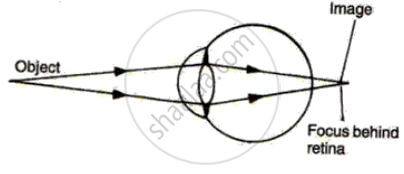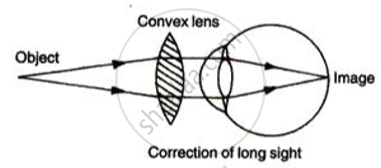Advertisements
Advertisements
Question
The diagram alongside represents a certain defect of vision of the human eye.
(i) Name the defect.
(ii) Describe briefly the condition in the eye responsible for the defect.
(iii) Redraw the figure by adding a suitable lens correcting the defect. Label the parts through which light-rays pass.
(iv) What special advantage do human beings derive in having both eyes facing forward?

Solution
(i) Hypermetropia.
(ii) There are two main conditions in the eye which is responsible for this defect :
1. Shortening of the eyeball from front to back.
2. The lens is less concave.
(iii) Correction of Hypermetropia:

(iv) Both the eyes facing forward helps in judging the depth or relative distance. This is due to overlapping images formed in brain from both eyes which focus on an object together at one time.
APPEARS IN
RELATED QUESTIONS
A person got his eyes tested by an optician. The prescription for the spectacle lenses to be made reads :
Left eye : +2.50 D
Right eye : +2.00 D
Which lens bends the light rays more strongly?
Describe and explain, how a normal eye can see objects lying at various distances clearly.
Draw a simple diagram of the human eye and label clearly the cornea, iris, pupil, ciliary muscles, eye-lens, retina, optic nerve and blind spot.
If you walk from a dark room into sunlight and back again into dark room, how would your pupils alter in size? What makes this happen?
Suggest how your irises help to protect the retinas of your eyes from damage by bright light.
An object is moved closer to an eye. What changes must take place in the eye in order to keep the image in sharp focus?
With reference to the functioning of the eye, answer the question that follow:
What is the shape of the lens during near vision?
With reference to the functioning of the eye, answer the question that follow:
Name the two structure in the eye responsible for bringing about the change in the shape of the lens.
State the function of each of the following parts of the human eye:
(i) Cornea
(ii) Iris
(iii) Pupil
(iv) Retina
Millions of people of the developing countries are suffering from corneal blindness. This disease can be cured by replacing the defective cornea with the cornea of a donated eye. Your school has organised a campaign in the school and its neighbourhood in order to create awareness about this fact and motivate people to donate their eyes after death. How can you along with your classmates contribute in this noble cause? State the objectives of organising such campaigns in schools.
Give the main function of the following:
Lachrymal glands
Differentiate between:
Retina and Choroid.
State the Function:
Cornea
State the Function:
Aqueous humour
For the normal human eye, the near point is at ___________ cm.
Write an Explanation.
Minimum distance of distinct vision
______ is the structural and functional unit of living organisms.
The larynx has fold of tissue which vibrate with the passage of air to produce sound.
Explain the structure and functioning of Human eye. How are we able to see nearby as well as distant objects?
Name the part of the eye which gives colour to the eyes.
______ of the eye is comparable to the film of a camera.
